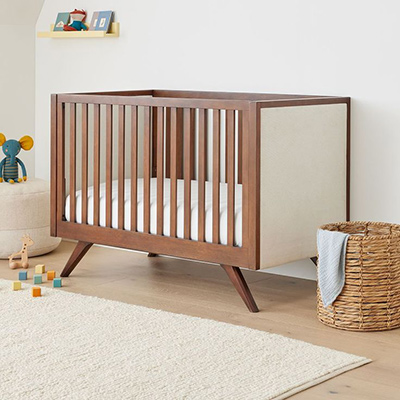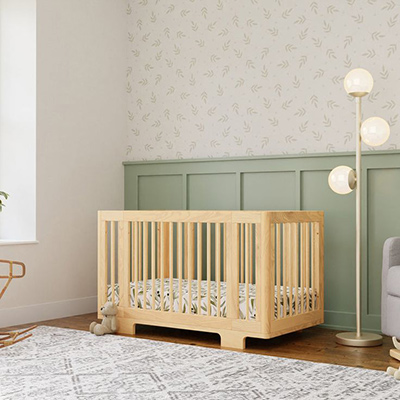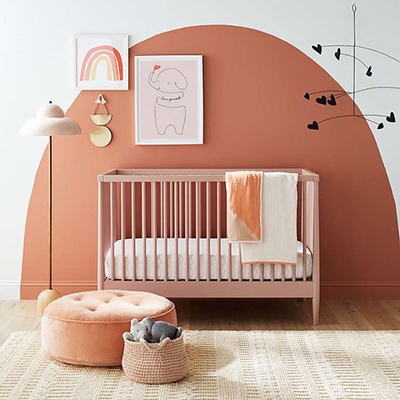Welcoming a new member into a family is a joyous occasion, and ensuring their safety, comfort, and development is of paramount importance. One essential piece of furniture that plays a significant role in this regard is the wooden baby cribs. In this blog, we will delve into the world of baby cribs, understanding their necessity, benefits, and addressing common questions that arise.

source: Pinterest
A crib is a specially designed bed for infants and toddlers. It typically features high sides to prevent the baby from rolling or falling out, ensuring their safety during sleep. Cribs come in various designs, materials, and sizes, catering to the diverse preferences of parents and the evolving aesthetics of nurseries.
Absolutely. While parents might consider alternative sleeping arrangements, such as bassinets or co-sleeping, a crib offers distinct advantages. Cribs provide a dedicated and secure sleeping space that promotes healthy sleep patterns and reduces the risk of Sudden Infant Death Syndrome (SIDS). Additionally, they enable parents to maintain a consistent sleep routine for their infants.

source: Pinterest
Baby wood cribs, crafted from sturdy and reliable materials, offer unparalleled safety for infants. The durability of wood ensures the crib can withstand the rigors of daily use, providing a secure space for babies to sleep and play.
The natural warmth and coziness of wood create a soothing ambiance that contributes to a peaceful sleep environment. Baby wood cribs are ergonomically designed to provide optimal comfort, helping babies to sleep soundly.
Wooden cribs exhibit timeless elegance that effortlessly complements various nursery themes and décor. They add a touch of sophistication to the nursery while maintaining a welcoming atmosphere.
Wooden cribs are known for their exceptional durability. When properly cared for, they can last through multiple children, making them a cost-effective investment for parents.
Baby wood cribs crafted from sustainably sourced materials demonstrate your commitment to environmental responsibility. This resonates with conscientious parents who prioritize eco-friendly products.
Wood is a versatile material that can be fashioned into a myriad of designs. Whether your customers prefer a classic look or a modern aesthetic, wooden cribs can cater to diverse style preferences.

source: Pinterest
Yes, newborns can and should sleep in a crib. To ensure safety, it's advisable to use a crib with adjustable mattress heights and closely follow safe sleep guidelines. Placing the baby on their back, avoiding soft bedding, and ensuring proper ventilation in the room are crucial aspects to consider.
Babies typically sleep in cribs from infancy through toddlerhood, which spans from birth to around 3 years of age. As they grow, you can adjust the crib to accommodate their changing needs, such as lowering the mattress to prevent climbing as they become more active.
The benefits of baby wood cribs are multifaceted, catering to the practical, aesthetic, and safety requirements of both parents and newborns. As a baby furniture owner, incorporating these cribs into your inventory showcases your dedication to providing high-quality, versatile, and sustainable products that resonate with the values of modern parents.
Q1: Are wood cribs safe for babies?
A: Yes, high-quality wood cribs are designed with safety in mind. They often meet stringent safety standards and regulations to ensure the well-being of infants.
Q2: Can I assemble a crib by myself?
A: While some cribs are designed for easy assembly, it's recommended to follow the manufacturer's instructions carefully. If you're uncertain, seeking professional assistance is advisable.
Q3: What crib mattress should I use?
A: Choose a firm and breathable crib mattress that fits snugly in the crib. Make sure it meets safety standards and guidelines to provide the best sleeping surface for your baby.
Q4: Can I use a crib for co-sleeping?
A: Co-sleeping is generally discouraged due to safety concerns. Instead, opt for a separate sleep space like a bassinet or crib placed near your bed for easy access to the baby.
Q5: Are there convertible cribs available?
A: Yes, many cribs are designed to convert into toddler beds, daybeds, or even full-sized beds as the child grows. This extends the utility of the crib and offers long-term value.
Q6: Are wood cribs easy to maintain?
A: Wood cribs are relatively easy to maintain. Regular cleaning and inspections for loose screws or damaged parts are recommended to ensure continued safety and functionality.
Q7: Are wood cribs heavier compared to cribs made from other materials?
A6: Wood cribs can be slightly heavier due to the nature of the material. However, this weight contributes to their stability and durability, ensuring a secure sleep environment for babies.